4. Camera Raw
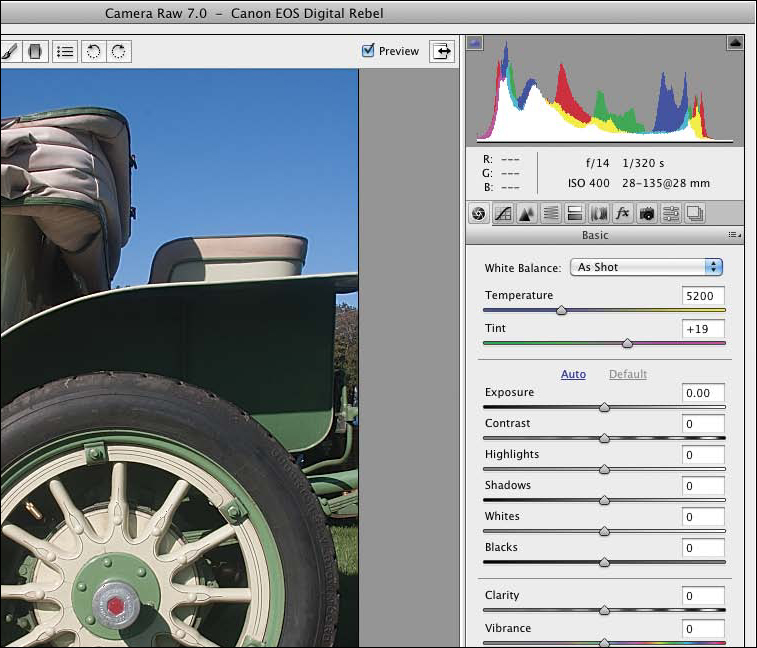
In This Chapter
Opening photos into Camera Raw
Cropping and straightening photos
Choosing default workflow settings
Using the Adjustment Brush tool
Using the Graduated Filter tool
Saving and applying Camera Raw settings
Synchronizing Camera Raw settings
Converting, opening, and saving Camera Raw files
Using the powerful controls in the Adobe Camera Raw plug-in, you can apply corrections to your photos before opening them into Photoshop.
In this chapter, you’ll learn how to open digital photos into the Camera Raw dialog and then use the controls to correct for defects, such as poor contrast, under- or overexposure, color casts, blurriness, under- and oversaturation, and noise. You will also learn how to enhance your photos with special effects, such as a vignette, grain texture, or tint; merge multiple exposures of the same photo; retouch blemishes; and save your Camera Raw settings as presets.
Notes: The Camera Raw plug-in is included with Photoshop. We refer to the dialog simply as “Camera Raw.” Some users also refer to the plug-in as “ACR,” short for Adobe Camera Raw.
Why use Camera Raw?
Amateur-level digital cameras store images in the JPEG or TIFF format, whereas advanced amateur and pro models offer the option to save images as raw data files, which offers substantial advantages. The camera applies internal processing to photos that are captured as JPEG or TIFF, such as sharpening, setting the white balance, and automatic color adjustments. With raw files, you get only the original raw information that the lens captured onto the camera’s digital sensor, leaving you with full control over subsequent image processing and correction. Each camera manufacturer creates its own variation of a raw file. (For a further discussion of raw files versus JPEG and TIFF files, see page 53.)
The following are some of the advantages to using Camera Raw:
• Camera Raw can process raw, TIFF, and JPEG photos from most digital camera models.
• Camera Raw offers powerful controls for correcting problems in your photos, such as over- and under-exposure and color casts, and for adding enhancements, such as a vignette or a grain texture.
• In the case of raw files, Camera Raw edits are saved as instructions in either a separate “sidecar” file or in the Camera Raw database. For TIFF and JPEG files, the instructions are saved in the photo file itself. When you open a photo from Camera Raw into Photoshop, regardless of the file format, the instructions (corrections) are applied to a copy of the file.
More reasons to use Camera Raw
In case you’re not fully convinced, we’ll explore more reasons for using the Camera Raw plug-in instead of opening your digital photos directly into Photoshop.
Ability to preview raw files: The only way to preview a raw photo is through a raw converter, such as Camera Raw. Note: The photo that you view on the LCD screen of your digital camera is merely a JPEG preview of the raw capture, not the “actual” raw capture.
Great correction features: Camera Raw offers many unique and powerful adjustment controls that you simply won’t find in Photoshop.
Less-destructive edits: When applying corrections to a photo, the goal is to preserve as much of the image quality as possible. Adjustments that are made to a photo in Camera Raw (and that are applied automatically when the photo is opened in Photoshop) cause less data loss than similar adjustment commands in Photoshop.
16 bits per channel: To preserve more of the original pixel data in a raw photo, Camera Raw keeps the bit depth as 16 bits per channel. Having more original data at the outset helps offset the data loss from subsequent image edits that are made in Photoshop, so the end result is a better-quality photo.
Tonal redistribution: The sensor in a digital camera captures and records the existing range of tonal values in a scene as is, in a linear fashion, without skewing the data toward a particular tonal range.A That sounds fine on paper, but the reality is that the human eye is more sensitive to lower light levels than to higher light levels. In other words, we’re more likely to notice if shadow areas lack detail and less likely to notice extra details in highlight areas. The result is that digital photos often contain more data than is needed about the highlight values in a scene and insufficient data about the lower midtone and shadow values. In a Camera Raw conversion, data in your photo is shifted more into the midtone and shadow ranges, which not only helps compensate for this peculiarity of human vision, but also helps prepare your photos for subsequent image edits in Photoshop.B If you apply tonal adjustments in Photoshop to a photo that contains insufficient shadow data, the result is posterization and a noticeable loss of detail; if you apply the same edits to a photo that has been converted in Camera Raw, the destructive edits will be far less noticeable.
Superior noise reduction and sharpening: Not to knock Photoshop, but the noise reduction and sharpening features in Camera Raw are easier to use, cause less data loss, and are more effective than similar features in Photoshop.
Learning about Camera Raw will give you a head start: The Camera Raw controls that you will use to apply tonal and color corrections to your photos are similar to many of the adjustment controls in Photoshop (e.g., Levels, Curves, and Hue/Saturation) that we explore in later chapters. As you proceed through the lessons in this book, you will build on the skills you have mastered in this chapter.
Raw, JPEG, or TIFF?
Unfortunately, Camera Raw can’t correct deficiencies in digital JPEG and TIFF photos as fully as it can in raw photos, for several reasons. First, digital JPEG and TIFF photos have been processed down to a bit depth of only 8 bits per channel by the camera, unlike raw photos, in which all of the captured pixels are preserved and are saved at a bit depth of 16 bits per channel.
Secondly, color and tonal processing is applied to JPEGs and TIFFs by the camera (“in camera”). Camera Raw must reinterpret this processed data, with less successful results than when it has access to the raw, unprocessed data.
All of the above notwithstanding, if your camera doesn’t shoot raw photos or you acquire JPEG or TIFF photos from other sources, you can still use practically all of the outstanding correction and adjustment features in Camera Raw to process them.
Note: In this chapter, we focus only on processing raw and JPEG files in Camera Raw — not TIFFs. The JPEG format is mentioned only when a particular feature treats JPEGs differently from the way it treats raw files.
• Each digital camera model attaches a different extension to the names of its raw files, such as .nef for Nikon and .crw or .cr2 for Canon.
Opening photos into Camera Raw
To standardize your workflow, we recommend setting a preference so your JPEG or TIFF photos will open directly into Camera Raw instead of into Photoshop.
To set a preference so your raw photos open directly into Camera Raw
1. In Photoshop, go to Edit/Photoshop > Preferences (Ctrl-K/Cmd-K) > File Handling.
2. Under File Compatibility, check Prefer Adobe Camera Raw for Supported Raw Files, then click OK. When you double-click a raw file, it will open into Camera Raw (as opposed to other software that converts raw files).
To set a preference so your JPEG or TIFF photos open directly into Camera Raw
1. In Bridge, choose Edit/Adobe Bridge CS6 > Camera Raw Preferences.
2. At the bottom of the dialog, from the JPEG menu, choose Automatically Open JPEGs with Settings, and from the TIFF menu, choose Automatically Open TIFFs with Settings, then click OK (see the Note below).
Now if you click a JPEG or TIFF photo thumbnail in Bridge, then click the Open in Camera Raw button ![]() or press Ctrl-R/Cmd-R, the file will open into Camera Raw.
or press Ctrl-R/Cmd-R, the file will open into Camera Raw.
Note: If you shoot only raw or JPEG photos (not TIFF photos), you can use the approach that we follow to have your raw and JPEG photos open into Camera Raw and your TIFF files open directly into Photoshop: Choose the JPEG setting we recommend in step 2 (in this task), but for the TIFF setting, choose Disable TIFF Support.
• If you have chosen both Automatically Open options suggested above, but for some reason you want to open a JPEG or TIFF photo directly into Photoshop instead of into Camera Raw (and if the file hasn’t yet been edited in Camera Raw), click the thumbnail, then press Ctrl-O/Cmd-O.
• If the Open in Camera Raw button ![]() is available when you click a thumbnail, you know that the file can be opened into Camera Raw.
is available when you click a thumbnail, you know that the file can be opened into Camera Raw.
You can set a preference to have either Bridge or Photoshop “host” the Camera Raw plug-in when you open a raw or JPEG photo. In the case of Photoshop, the program will launch, if it’s not already running.
To choose a host for Camera Raw
1. In Bridge, choose Edit/Adobe Bridge CS6 > Preferences (Ctrl-K/Cmd-K) > General.
2. Check Double-Click Edits Camera Raw Settings in Bridge if you want the Camera Raw dialog to be hosted by Bridge when you double-click the thumbnail in Bridge for a raw photo or for a JPEG that was previously edited in Camera Raw, or uncheck this option to have those files open into Camera Raw, hosted by Photoshop. Click OK.
Note: When Bridge is the host for Camera Raw, the default button for exiting that dialog is labeled Done, whereas when Photoshop is the host for Camera Raw, the default exit button is Open Image. (If the button is labeled Open Object instead of Open Image, see the tip on page 58.)
After setting the necessary preferences, familiarize yourself with these generic steps for opening and processing photos in Camera Raw.
To open a raw or JPEG digital photo into Camera Raw
1. Launch Bridge, display the thumbnail for a raw or JPEG photo, then do either of the following:
For a raw photo, double-click the thumbnail.
For a raw or JPEG photo, click the thumbnail, then press Ctrl-R/Cmd-R or click the Open in Camera Raw button on the Bridge toolbar ![]() (or right-click the photo in standard or Review mode and choose Open in Camera Raw).
(or right-click the photo in standard or Review mode and choose Open in Camera Raw).
• To open a file from the Mini Bridge panel in Photoshop into Camera Raw, right-click the thumbnail and choose Open With > Camera Raw from the context menu.
2. The Camera Raw dialog opens.A An alert symbol ![]() may display in the upper-right corner of the preview while Camera Raw reads in the image data, and will disappear when it’s done.
may display in the upper-right corner of the preview while Camera Raw reads in the image data, and will disappear when it’s done.

A The Camera Raw dialog
Information about your photo (taken from the metadata that was embedded into it by the camera) is listed in several locations: the camera model in the title bar at the top of the dialog; the file name below the preview; and the camera settings used to take the photo (aperture, shutter speed, ISO, and focal length) below the histogram.
The adjustment features are found in 10 tabs: Basic, Tone Curve, Detail, HSL/Grayscale, Split Toning, Lens Corrections, Effects, Camera Calibration, Presets, and Snapshots. Switch among the tabs to correct your photo (we cover most of the tabs in depth in this chapter).
3. When you’re done correcting the photo, you can either click Open Image to open the photo into Photoshop or click Done to close Camera Raw without opening the photo. In either case, the Camera Raw settings will stick to the photo, and the original data will be preserved.
The Camera Raw tools A

A The shortcuts for the Camera Raw tools are listed in boldface above.
In the upper-left corner of the dialog, click the Zoom tool, ![]() then click the image preview to zoom in or Alt-click/Option-click it to zoom out.
then click the image preview to zoom in or Alt-click/Option-click it to zoom out.
Use the Hand tool ![]() to move a magnified preview image in its window (or if another tool is selected, hold down the Spacebar for a temporary Hand tool).
to move a magnified preview image in its window (or if another tool is selected, hold down the Spacebar for a temporary Hand tool).
For the White Balance tool, ![]() see the sidebar on page 60.
see the sidebar on page 60.
Choose the Color Sampler tool, ![]() then click in the image preview to place up to nine samplers. A readout pertaining to the RGB components below each sampler displays below the tool box; the readouts will update as you make color and tonal adjustments. To reposition a sampler, drag it with the Color Sampler tool. To remove all samplers, click Clear Samplers.
then click in the image preview to place up to nine samplers. A readout pertaining to the RGB components below each sampler displays below the tool box; the readouts will update as you make color and tonal adjustments. To reposition a sampler, drag it with the Color Sampler tool. To remove all samplers, click Clear Samplers.
For the Targeted Adjustment tool ![]() (or TAT for short), see pages 66–67 and 71.
(or TAT for short), see pages 66–67 and 71.
For the Crop ![]() and Straighten
and Straighten ![]() tools, see the facing page.
tools, see the facing page.
For the Spot Removal ![]() tool, see page 80.
tool, see page 80.
The Red-Eye Removal tool ![]() works like the Red-Eye tool in Photoshop (for the latter, see page 293).
works like the Red-Eye tool in Photoshop (for the latter, see page 293).
For the Adjustment Brush tool, ![]() see pages 72–74.
see pages 72–74.
For the Graduated Filter tool, ![]() see pages 78–79.
see pages 78–79.
Note: If tool settings are displaying on the right side of the Camera Raw dialog (e.g., if you were using the Adjustment Brush tool) and you want to redisplay the row of tab icons, click one of the first seven tools.
• The tools in Camera Raw are “memory-loaded,” meaning that you can toggle them. Press a tool shortcut to select a different tool, then press the same key again to return to the original tool.
Other buttons at the top of the dialog:
• The Open Preferences Dialog button ![]() (or press Ctrl-K/Cmd-K) opens the Camera Raw Preferences dialog.
(or press Ctrl-K/Cmd-K) opens the Camera Raw Preferences dialog.
• The Rotate 90° Counterclockwise button ![]() and the Rotate 90° Clockwise button
and the Rotate 90° Clockwise button ![]() rotate the image. The results preview in the dialog.
rotate the image. The results preview in the dialog.
Cropping and straightening photos
With the Crop and Straighten tools, you can control which portion of a photo opens into Photoshop. You can readjust the crop box at any time without losing any image data, and the outlying areas will remain available even after you click Save, Done, or Open.
To crop a photo
1. Open a photo into Camera Raw (see step 1 on page 55). Choose the Crop tool ![]() (C).
(C).
2. Drag a crop box in the preview image.A To move the box, drag inside it; to resize it, drag a handle.

A With the Crop tool, we drew a crop box in the preview window. Here, we are resizing the box.
3. To preview the crop results, press Enter/Return or click another tool.
To straighten a crooked photo
1. Choose the Straighten tool ![]() (A).
(A).
2. Drag along an edge in the photo that you want to align to the horizontal or vertical axis.B A crop box will display, aligned to the angle you drew.C

B With the Straighten tool, we are dragging along an edge that we want to align to the vertical or horizontal axis.

C A crop box displays in Camera Raw.
3. To preview the straighten results, press Enter/Return or click another tool.D

D We pressed Enter/Return to preview the results.
• To redisplay the current crop box after using another tool, click the Crop or Straighten tool again. If you want to remove the box, press Esc.
Choosing default workflow settings
Via the Workflow Options dialog, you can change the color space, dimensions, bit depth, and resolution of a photo before opening it into Photoshop — without altering the original digital file. Your choices will become the new default settings.
To choose default workflow settings
1. Open a photo into Camera Raw, then at the bottom of the dialog, click the underlined link that lists the color space, bit depth, etc. The Workflow Options dialog opens.A
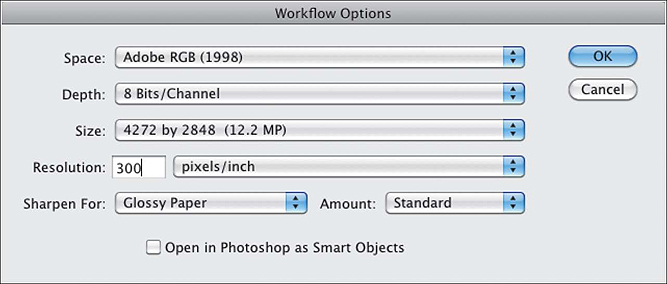
A Use the Workflow Options dialog to choose color space, bit depth, size (dimensions), and resolution settings for the current — and future — photos.
2. From the Space menu, choose a color profile to be used for converting the raw file to RGB: Adobe RGB (1998), ColorMatch RGB, ProPhoto RGB, or sRGB IEC61966-2.1 (or “sRGB,” for short). In Chapter 1, you assigned Adobe RGB (1998) as the default color space for color management. To ensure color consistency, you should choose it here, too.
3. From the Depth menu, choose a color depth of 8 Bits/Channel or 16 Bits/Channel (see page 17). If you have a large hard disk and a fast system with a lot of RAM, choose 16 Bits/Channel. With the extra pixels, more of the original tonal levels in your photo will be preserved when you edit it in Photoshop.
4. If you need to resize the image, from the Size menu, choose a preset size (in megapixels) that matches the proportions of the raw image. (The default size is the one without a minus sign – or plus sign +.) Resampling will occur if you choose a larger size than the original. To help prevent loss of detail, avoid choosing the largest size. (Experts disagree on whether it’s better to resample an image in Camera Raw or in Photoshop. Until a consensus is reached, you can decide for yourself.) Note: If the photo has a crop box, the Size menu will be labeled as Crop Size, and it will list the current crop size.
5. Enter a Resolution. This value affects only the print output size. (For instance, to output an image that is 2000 × 3000 pixels or larger to an inkjet printer or to a commercial press, you would choose a resolution of 240–300 ppi.)
6. Optional: From the Sharpen For menu, choose None, Screen, Glossy Paper, or Matte Paper; predefined output sharpening will be applied to your photo for that medium. From the Amount menu, choose the desired level of sharpening (Standard is usually a good choice).
Note: The sharpening values that Camera Raw applies via this dialog aren’t listed anywhere.
If you want to control the sharpening values, choose None from the Sharpen For menu and use the sliders in the Detail tab instead (see page 68).
7. Click OK. The new workflow settings will be listed below the preview, and will be applied to the current photo and to photos that you subsequently open into Camera Raw.
• To have future photos open from Camera Raw into Photoshop as a Smart Object when you click Open Object, check Open in Photoshop as Smart Objects in the Workflow Options dialog (see page 249). Turn this feature on only if it suits your usual workflow.
Using the Camera Raw tabs

Click a tab icon to access a specialized category of options.

Basic tab: Adjust the white balance and exposure (see pages 61–65).

Tone Curve tab: Fine-tune the midtones (see pages 66–67).

Detail tab: Apply capture sharpening and reduce noise (see pages 68–69).
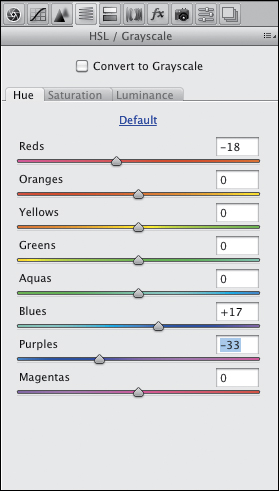
HSL/Grayscale tab: Adjust the properties of individual colors (see pages 70–71).
In Camera Raw, we perform most of our correction work in the four tabs shown above.
To restore default settings to sliders in the Camera Raw tabs
As you work in Camera Raw, you may find a need to undo or reset your slider settings. Use any of the following methods:
• Double-click a slider to reset its value to 0 (or, in the Detail tab, to the default value).
• Shift-double-click a slider in the Basic tab to reset it to the Auto value.
• Click Default in the Basic or HSL/Grayscale tab to reset all the sliders in just the current tab to 0.
• Hold down Alt/Option and click Reset (Cancel becomes Reset) to restore the settings, in all tabs, that were in effect when you opened the dialog.
(To learn about related options on the Camera Raw Settings menu, see the next page.)
When you open a photo into Camera Raw, by default, it’s adjusted according to the built-in profile that was created for your camera model. Also, all the sliders in the Basic tab are set to 0 automatically. To assign a different collection of settings to your file, or to restore the original settings, see the options below.
To restore settings via the Camera Raw Settings menu
From the Camera Raw Settings menu, ![]() choose one of these options: A
choose one of these options: A

A Use options on the Camera Raw Settings menu to restore the default settings to your photo or to reapply the prior settings.
Image Settings to restore the settings that were attached to the file from either the initial photo shoot or a prior Camera Raw session. When a photo is first opened into Camera Raw, these settings will be the same as the Camera Raw Defaults settings.
Camera Raw Defaults to remove any custom settings and reapply the default settings for your camera model, your specific camera, or the ISO setting that was used to take the photo.
Previous Conversion to apply the settings from the last image that was adjusted in Camera Raw.
Custom Settings to reapply all the custom settings that you chose since opening the Camera Raw dialog.
If a user-saved preset is applied to the current photo, that preset will also be listed as an option on this menu (see page 81).
Using the Basic tab
The Basic tab is rightly named (and displays first, by default) because it contains the most essential correction features of Camera Raw. We have divided the use of this tab into several tasks, beginning with the White Balance sliders on this page, then proceeding through exposure, contrast, and saturation adjustments on pages 62–65.
Using the White Balance controls, you can begin by neutralizing the color temperature of your photo.
To apply white balance adjustments via the Basic tab
1. With a photo open in Camera Raw, click the Basic tab, ![]() A and double-click the Hand tool
A and double-click the Hand tool ![]() in the toolbox to fit the photo in the preview window.
in the toolbox to fit the photo in the preview window.

A When a photo is first opened into Camera Raw, the White Balance menu in the Basic tab is set to As Shot. This photo has a high Temperature value and looks too warm (yellowish).
2. Do either of the following:
From the White Balance menu, choose a preset that best describes the lighting conditions in which the photo was taken. (Note: The presets are available only for raw files.) Choose As Shot at any time to restore the original camera settings.
Lower the Temperature value to add blue and make the image look cooler,B or raise it to add yellow and make the image look warmer.C To fine-tune the temperature correction, move the Tint slider slightly to the left to add a bit of green or to the right to add magenta. (The White Balance menu listing changes to Custom, because you chose manual settings.)

B We lowered the Temperature value too much, so now the photo looks too cool (has a bluish cast).

C For this photo, a Temperature value of 5500 strikes the correct balance between warm and cool.
In the histogram in the Camera Raw dialog, the red, green, and blue areas represent the three color channels in a photo, and the white areas represent the areas where those three colors overlap. Clipping, the shifting of tonal values to absolute black or white in a photo, occurs if the tonal range of a scene is wider than the range that can be captured by the camera. You can tell that pixels are clipped in a photo if the vertical bars are clustered in tall peaks at one or both ends of the histogram (shadow pixels on the left, highlight pixels on the right).
In Camera Raw, your goal is to minimize clipping by bringing the pixels into the range of your chosen RGB color space. As you make slider adjustments, the tonal values in the photo will be redistributed, and the histogram will update accordingly. Note: Remember, we recommended that you choose Adobe RGB as the color space both for your camera (see page 8) and for Camera Raw (see page 58).
To turn on the histogram clipping warnings for the preview
In the top left corner of the histogram, click the Shadow Clipping Warning button (U);A shadow clipping displays as blue. In the top right corner, click the Highlight Clipping Warning button (O); highlight clipping displays as red. (Note: When the buttons are activated, they have a white border.)

A Use the Clipping Warning buttons to allow Camera Raw to display blue and red highlights on any clipped areas of your photo.
Next, use the middle batch of sliders in the Basic tab to apply tonal corrections to your photo, preferably in the order listed in the dialog (there’s a logic to the sequence). At first, all the sliders are set to 0 and the underlined word “Default” is dimmed.
To apply exposure and contrast adjustments via the Basic tab 
1. Turn on the Clipping Warning buttons.
2. Use the Exposure slider to lighten or darken the entire photo, as needed.
3. Use the Contrast slider to increase or reduce the color intensity and tonal contrast (A–B, next page).

A This original photo is underexposed (too dark), so the colors look dull.

B The blue warning color in the preview alerts us that shadow details in the photo are clipped. Our goal is to lighten the overall photo and recover details in the midtones and shadows, without washing out the highlights. We increased the Exposure value in the Basic tab first, then increased the Contrast value to intensify the highlights, shadows, and color saturation. We’re not concerned that the photo is still too dark, as we can lighten it with further adjustments.
4. If you increased the contrast, more than likely the highlights and shadows now need to be adjusted:
To restore details in the highlights, move the Highlights slider to the left until only a smidgen remains of the red highlight warning color.
To restore details in the shadows, move the Shadows slider to the right until only a smidgen remains of the blue shadow warning color.A (This slider is similar to the now defunct Fill Light slider.) Or if you need to darken the shadows, move this slider to the left.

A We reduced the Highlights value to recover details in the sky and increased the Shadows value to recover details in the shadows and lower midtones. The colors and detail in the midtones, and the overall balance of lights and darks, are improved. However, reducing the Highlights value had the effect of making the white areas look dull.
5. Now that details have been restored to the midtones and highlights, you’re ready to adjust the whites and blacks:
Increase the Whites value to brighten the white areas in the photo. This slider also has the effect of lightening the upper midtones and brightening the colors.
Use the Blacks slider to lighten or darken the black areas (A, next page). This slider may also affect the color brightness.

A We increased the Whites value to lighten the upper midtones and brighten the whites, and moved the Blacks slider to recover more details in the shadows. Overall, the brightness, as well as the colors, are much improved.
• If the colors are now washed out as a result of your increasing the Whites or Blacks value, one remedy is to try increasing the Contrast value.
• To further adjust the tonal values in the midtones, see pages 66–67.
To apply edge contrast and color saturation adjustments using the Basic tab
1. To add depth by adjusting the edge contrast in the midtones, increase the Clarity value, or reduce this value if you want to deliberately soften the photo (such as in a portrait or landscape).
2. Change the Vibrance value to adjust the color saturation.B
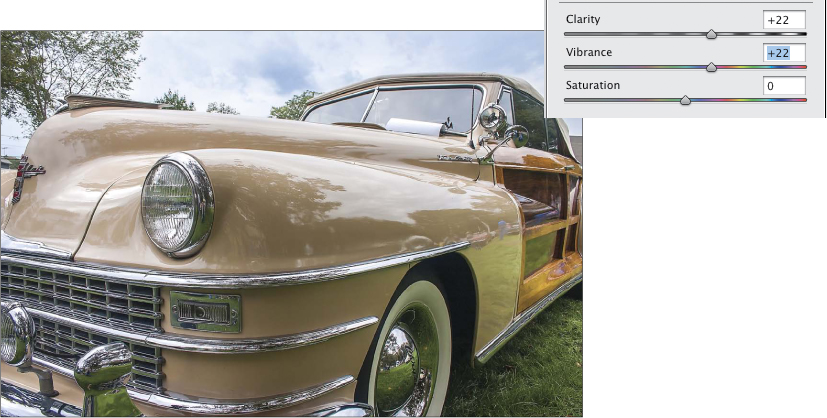
B Finally, we increased the Clarity and Vibrance values slightly to intensify the details and color saturation (e.g., note the change on the car body). Our cumulative adjustments to this photo improved the contrast, clarified the details, and produced richer color. Vroom, vroom!
3. Turn off both clipping warnings by pressing U, then O.
• We recommend using the Vibrance slider instead of the Saturation slider to adjust color saturation because the former is less likely to cause oversaturation (and it protects skin tones), whereas the latter is more likely to cause oversaturation and highlight clipping. To view the effect of this, drag the Saturation slider to the far right.
Using the Tone Curve tab
After using the Basic tab, a next logical step is to make a more refined adjustment of the upper and lower midtones, which we recommend performing individually via the Parametric sliders in the Tone Curve tab. (If you use Adobe Photoshop Lightroom, these Parametric controls will look familiar.)
Note: We avoid manipulating the curve in the nested Point tab, because a misshapen curve can cause a photo to look posterized. The sliders in the Parametric tab don’t cause this problem.
To apply tonal adjustments using the Parametric sliders in the Tone Curve tab
1. With a photo open in Camera Raw,A click the Tone Curve tab, ![]() then the nested Parametric tab. Behind the curve you’ll see a static display of the current histogram.
then the nested Parametric tab. Behind the curve you’ll see a static display of the current histogram.

A In this photo, the midtones are so dark that few details are visible in those areas.
2. Do either of the following:
If you adjusted the Highlights and Shadows sliders in the Basic tab, leave the Highlights or Shadows sliders in this tab alone and tweak the upper and lower midtones using the Lights and Darks sliders. If you didn’t touch the Highlights and Shadows sliders in the Basic tab, you can use the Highlights, Lights (upper midtones), Darks (lower midtones), or Shadows sliders to lighten or darken each tonal range. As you do this, the corresponding portion of the curve will be raised above or lowered below the diagonal line (A–B, next page).

A To lighten the lower midtones, we increased the Darks value, which raised the middle of the curve.
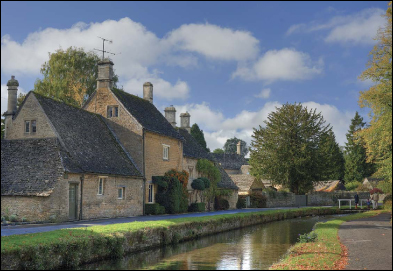
B With the lower midtones now lighter, some details are now visible in the midtones, such as on the sides of the buildings and on the side and surface of the canal. However, the sky area looks a bit dull.
Click the Targeted Adjustment tool ![]() (T). Drag in an area of the photo where the tonal range needs adjustment (C, next page). As you do this, the slider and curve that correspond to the tonal range under the pointer will move accordingly.
(T). Drag in an area of the photo where the tonal range needs adjustment (C, next page). As you do this, the slider and curve that correspond to the tonal range under the pointer will move accordingly.

C To lighten the upper midtones (and thereby brighten the clouds, sky, and trees), we dragged upward over a light midtone area with the Targeted Adjustment tool; the Lights value increased automatically.
• To boost the contrast in a photo, try moving the Lights slider to the right and the Darks slider to the left.
3. To control the range of tonal values that are affected by the slider adjustments you made in step 2, move any of the region controls (located below the graph). The left region control affects the Shadows slider, the right region control affects the Highlights slider, and the middle region control affects both the Lights and Darks sliders (D–E, next page). If moving the control raises the curve, adjacent tonal ranges are lightened; if moving the control lowers the curve, adjacent tonal ranges are darkened.

D Finally, we moved the middle region control slightly to the right, which further lightened the sky. (Both the tool and region control edits raised the upper section of the curve.)

E Now the tonal values in the image look just right.
• To quickly select the Targeted Adjustment tool and display the Parametric sliders, press Ctrl-Alt-Shift-T/Cmd-Option-Shift-T.
Using the Detail tab
Via the Sharpening sliders in the Detail tab, you can adjust the sharpness of your photo (this is called “capture” sharpening), and via the Noise Reduction sliders, you can reduce any unwanted color noise.
To sharpen a photo using the Detail tab
1. Click the Detail tab ![]() A and choose a zoom level of 100%.
A and choose a zoom level of 100%.

A These are the Sharpening controls in the Detail tab.
• To move a different area of the photo into view, hold down the Spacebar and drag.
Note: If the words “Sharpening (Preview Only)” display at the top of the Detail tab, click the Open Preferences button ![]() in the toolbox. In the Camera Raw Preferences dialog, choose Apply Sharpening To: All Images, then click OK.
in the toolbox. In the Camera Raw Preferences dialog, choose Apply Sharpening To: All Images, then click OK.
2. Under Sharpening, use the Amount slider to adjust the degree of edge definition. For subject matter that needs a lot of sharpening, such as hard objects or buildings, set this slider to 100; if less sharpening is needed, try a value of 50–60 (for a JPEG photo, the default value is 0).
• To evaluate the sharpening effect for a slider using a grayscale preview, Alt-drag/Option-drag the slider, then release.
3. Use the Radius slider to control how many pixels surrounding an edge are modified. We recommend keeping this value between 1 and 1.3.
4. Alt-drag/Option-drag the Detail slider slightly to the right to sharpen edge details and textures.
5. Alt-drag/Option-drag the Masking slider to around 50 to protect low-contrast areas with a black mask, and thereby sharpen only high-contrast areas.
All digital cameras produce some luminance (grayscale) noise and color artifacts (random extraneous pixels). Although budget cameras tend to produce the most noise, it can also be produced by a high-end camera, if used with a high ISO (light sensitivity) setting to capture a poorly lit scene. It’s a good idea to remove as much noise from your photos as possible in Camera Raw, because it can become accentuated by image editing in Photoshop.
As you follow these steps, you’ll discover that after you shift one slider, another one will need adjusting.
To reduce luminance and color noise using the Detail tab
1. With a photo open in Camera Raw (A, next page), click the Detail tab ![]() and choose a zoom level of 200–300% for the preview.
and choose a zoom level of 200–300% for the preview.

A This is a close-up of a photo of a shop window (viewed at a zoom level of 300%), with the Noise Reduction: Luminance and Color sliders set to 0 (no noise reduction applied). Grayscale noise is evident in the signage, and color artifacts are evident on the poorly lit interior surfaces behind the letters.
2. To reduce grayscale noise (graininess), increase the Luminance value (B, next page). Try a value between 20 and 70.

B To remove noise from the letters, we increased the Luminance value to 69, but this also diminished the edge definition.
3. Raising the Luminance value can have the effect of smoothing out the high-contrast edges in a photo. To resharpen those edges, raise the Luminance Detail value, but not so much that noise is reintroduced (C, next page).
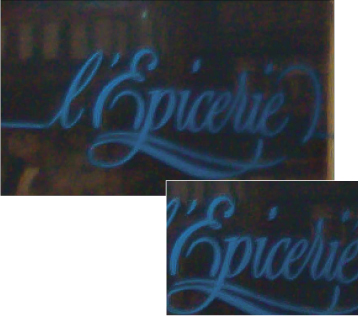
C To resharpen the edges of the letters, we increased the Luminance Detail value to 65.
• To move a different area of the photo into view, hold down the Spacebar and drag.
4. Raise the Luminance Contrast value to restore some edge contrast. The effect of this slider is most noticeable in photos that contain a lot of noise.
5. Color artifacts and random speckling tend to be most noticeable in solid-color areas of a photo (e.g., flat surfaces), especially in shadow areas. To reduce these defects, increase the Color value from the default value of 25 to around 40–50, depending on the subject matter of the photo (for a JPEG photo, the default value is 0).
6. Raising the Color value may lower the intensity of colors in areas of the photo that were poorly lit. To restore some saturation and intensity to those areas, increase the Color Detail value from the default value of 50 to around 75, or until the color saturation looks just right (D, next page).
D To remove color artifacts from the dark areas, we increased the Color value to 40, which also had the effect of desaturating the colors. To revive the colors and produce the final version of the image (shown at left), we increased the Color Detail value to 60.
• To reduce noise in select areas, use the Adjustment Brush tool (see pages 72–74).
• To judge the overall effect of the settings you have chosen in this tab, lower the zoom level.
Using the HSL/Grayscale tab
Using the powerful sliders in the HSL/Grayscale tab, you can adjust the hue, saturation, and luminance of each hue individually.
To adjust individual colors via the HSL sliders
1. Click the HSL/Grayscale tab, ![]() and double-click the Hand tool
and double-click the Hand tool ![]() to fit the image in the preview.A
to fit the image in the preview.A

A In the original photo, the sky lacks contrast and the reds on the car body are slightly undersaturated.
2. Click the nested Hue tab. Move any slider to shift that color into adjacent hues, as shown in the bar. For example, you could shift the Greens toward yellow to make a landscape look warmer, or toward aqua to make it look cooler.
3. Click the Saturation tab. Move any slider to the left to desaturate that color (add gray to it) or to the right to make it more vivid (pure).B–C Avoid oversaturating the photo, to ensure that it looks realistic and stays printable.

B In the nested Saturation tab of the HSL/Grayscale tab, we reduced the saturation of the Yellows and increased the saturation of the Reds and Blues.
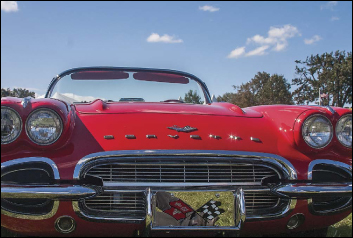
C The Saturation adjustments intensified the reds in the car (particularly in the upper midtones) and intensified the blues in the sky.
• To make a sky look more vivid, increase the saturation of the Blues and Aquas. To make a sunset look warmer, increase the saturation of the Oranges or Yellows; or to make it look gray and hazy, reduce those values.
4. Click the Luminance tab.A–B Move a slider to the left to darken that color (add black) or to the right to lighten it (add white). Avoid lightening any of the colors too much, to keep the highlights from being clipped.

A In the nested Luminance tab, we lightened the Oranges and darkened the Reds, Yellows, Greens, and Blues. (Tip: The effect of reducing the Blues value is like shooting with a polarizing filter on a camera.)

B It may seem counterintuitive, but decreasing the Blues darkened the colors in the sky, while decreasing the Reds and increasing the Oranges produced a brighter, richer red on the car body. Now the colors are equally intense in the upper and lower areas of the photo.
• For a more accurate rendering of your adjusted pixels, choose a zoom level of 66% or 100% for the Camera Raw preview.
Using the Adjustment Brush tool
Unlike corrections made via the Camera Raw tabs, which apply to the overall photo, corrections made with the Adjustment Brush tool are “local” (affect specific areas of the photo). You apply a mask in the preview to define which areas are going to be affected by the adjustment, then you apply the correction via the sliders. Use this tool after you have finished your broad, overall corrections, to fix a few specific areas or to accentuate some details.A Awesome feature!

A We studied this photo and decided on improvements to be made: Smooth the skin, sharpen the eyelashes, darken the eyebrows, and minimize the under-eye circles.
To apply local edits with the Adjustment Brush tool
1. After making adjustments in the Basic and Tone Curve tabs, click the Adjustment Brush tool ![]() (K). The sliders for the tool display (some are the same as sliders in the Basic tab). The Temperature, Tint, Highlights, Shadows, Noise Reduction, and Moire Reduction sliders are new.
(K). The sliders for the tool display (some are the same as sliders in the Basic tab). The Temperature, Tint, Highlights, Shadows, Noise Reduction, and Moire Reduction sliders are new. ![]()
2. Click the + or – button for any slider to “zero out” all the sliders except the one you click.
3. For the brush settings, try a Feather value of 60–95 (to allow the edits to fade into surrounding areas), a Flow value of 60 (for the amount of adjustment produced by each stroke), and a Density value of 60 (for the level of transparency in the stroke).
4. Check Show Mask (Y) (scroll down in the settings area if you don’t see this option), adjust the brush size by pressing [ or ], then draw strokes over the areas of the photo that need adjustment. A tint covers the areas where you apply strokes, and a pin appears where you started dragging.B

B We clicked the Adjustment Brush tool, zeroed out the sliders, checked Show Mask, then drew strokes in the preview on the face (but not on the key facial details).
• The brush size is represented by the solid circle in the pointer; the feather value is represented by the black-and-white dashed circle.
5. Uncheck Show Mask, then use the sliders to apply adjustments to the masked areas (A, next page).

A We hid the mask, then chose a higher Tint value to add magenta to the skin tones, higher Exposure and Shadows values to lighten the skin tones, and lower Clarity and Sharpness values to smooth the skin texture. The results are shown at right.
6. To apply an adjustment to another area of the photo, click New, then repeat steps 2–5 (B–E, next page and A–C, page 74).
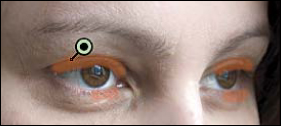
B To sharpen the eyelashes, we clicked New, checked Show Mask, then masked those areas.

C We hid the mask, then chose higher Contrast, Clarity, and Sharpness values to accentuate the masked areas, and a lower Exposure value to darken them.

D To darken the eyebrows, we clicked New, checked Show Mask, then masked those areas.
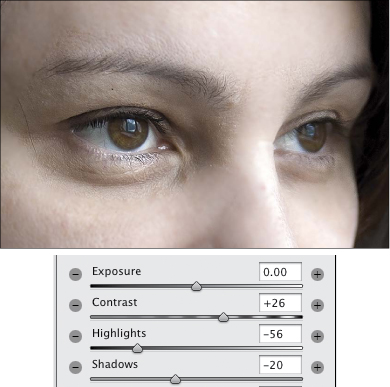
E We hid the mask, then chose a higher Contrast value to define the hairs more crisply against the skin, and lower Highlights and Shadows values for a darkening effect.

A To minimize the dark circles under the eyes, we clicked New, checked Show Mask, then applied a mask to those areas.

B We hid the mask, then reduced the Temperature value to cool the redness of the skin tones; increased the Exposure, Highlights, and Shadows values to lighten the skin; and reduced the Clarity and Sharpness values to soften the skin texture.

C This final image shows the cumulative results of all the local corrections that we applied via the Adjustment Brush tool.
• To show or hide all the pins, press V or check or uncheck Show Pins. To display the mask for an existing pin temporarily, with the mouse or your stylus, roll over the pin.
• To edit an adjustment, click a pin (a black dot appears), then add to the mask and/or move the sliders. To remove areas of a mask, see page 74.
To remove Adjustment Brush tool edits
1. With the Adjustment Brush tool ![]() selected (K), check Show Mask (Y) and Show Pins (V).
selected (K), check Show Mask (Y) and Show Pins (V).
2. Do either or both of the following:
To remove adjustments locally, click a pin, click the Erase button, then apply strokes where you want to erase the mask.
To remove a pin and its adjustments, click the pin, then press Backspace/Delete.
• To remove all Adjustment Brush tool edits and reset the mode to New, click the Clear All button.
Using the Split Toning tab
Using the Split Toning controls, you can apply one color tint (“tone”) to the highlight areas of a photo and a different tint to the shadow areas. For the best results with this technique (and to mimic its traditional origins), convert the colors in your photo to grayscale first. We’ve gotten good results on photos of metallic objects, such as the antique car shown here.A

A This is the original, full-color photo.
To apply a color tint to a grayscale version of a photo
1. Click the HSL/Grayscale tab, ![]() then check Convert to Grayscale.
then check Convert to Grayscale.
2. Click the Basic tab, and adjust the exposure and contrast.
3. Click the Split Toning tab. ![]()
4. Move both Saturation sliders approximately halfway across the bar to make it easier to judge the colors you will apply in the next step.
5. Move the Highlights Hue slider to tint the highlights B and the Shadows Hue slider to tint the shadows.

B After converting the colors in the photo to grayscale, we used the Split Toning tab to tint the highlights with a brownish yellow hue.
6. Readjust the Saturation value for each hue.
7. Reduce the Balance setting to apply more of the Shadows tint to the entire photo, or increase it to apply more of the Highlights tint to the entire photo.C–D

C Next, we tinted the shadows with blue, then moved the Balance slider to the right to favor the highlight color more.

D This is the final result of our Split Toning adjustments. Applying separate tints to the highlights and shadows accentuated the lines and graceful curves of this sleek antique.
Using the Effects tab
In the world of traditional film, the faster the speed, the larger and more apparent the grain. By using the Grain controls in Camera Raw, you can simulate this grainy texture, as a special effect. Choose a photo that won’t suffer aesthetically when the details lose definition.
To add a grain texture to a photo
1. Click the Effects tab, ![]() and double-click the Hand tool
and double-click the Hand tool ![]() to fit the image in the preview.A
to fit the image in the preview.A

A This photo is a good candidate for the Grain effect because it contains muted colors and we don’t mind if the details are softened.
2. Under Grain, to control the amount of grain applied, choose an Amount value of around 50 to make the grain noticeable.
3. To emulate the fine grain of slow film speed or the coarse grain of fast film speed, do as follows:
Increase the Size value for the size of the grain particles.B When this value is greater than 25, a small degree of blurring is also applied, to help blend the grain with the imagery.

B The first settings we chose were Grain Amount 50 and Size 80 (we left the Roughness control at the default value of 50). The food textures are beginning to blend with the soft background.
Reduce the Roughness value below the default value of 50 for a more uniform grain, or increase it for an uneven, coarse grain.C Zoom in to examine the grain, then readjust the Amount value, if needed.

C We changed the Amount to 75, the Size to 60, and the Roughness to 65. The coarser grain (increased Roughness) further unifies the highlights and background with the food textures. Please pass the Parmesan...
Using the Post Crop Vignetting controls, you can apply a light or dark vignette to a photo (lighten or darken the outer area). If you crop the photo subsequently in Camera Raw, the vignette will reconform to the new dimensions.
To apply a vignette to a photo
1. Click the Effects tab, ![]() and double-click the Hand tool
and double-click the Hand tool ![]() to fit the image in the preview.A
to fit the image in the preview.A

A This is the original image.
2. Under Post Crop Vignetting, do all of the following: B–D

B In the Effects tab, under Post Crop Vignetting, we chose the values above.

C We lowered the Midpoint value and raised the Feather and Highlights values.

D When we cropped the image, the vignette readjusted automatically.
Choose Style: Highlight Priority.
Choose a negative Amount value for a dark vignette or a positive value for a light vignette.
Adjust the Midpoint value to expand the vignette inward or outward.
Adjust the Roundness value to change the shape of the vignette (make it more oval or more round).
Adjust the Feather setting to control the transition between the vignetted and the nonvignetted areas.
Adjust the Highlights setting to control the brightness of the highlights within the vignette.
Using the Graduated Filter tool
When shooting landscapes, you may have run into this common predicament: You set the proper exposure for the foreground, and the sky winds up being overexposed. To solve this problem on site, you can reduce the light on the upper part of the lens with a graduated neutral-density filter. To darken a sky in a photo that is shot without such a filter (Plan B!), you can use the Graduated Filter tool in Camera Raw.
To darken part of a photo via the Graduated Filter tool 
1. After adjusting your photo via the Basic and Tone Curve tabs,A click the Graduated Filter tool ![]() (G). The sliders for the tool display.
(G). The sliders for the tool display.

A Despite our applying Basic and Tone Curve adjustments, the sky in this photo looks overexposed (washed out).
2. Click the + or – button for any slider to “zero out” all the sliders except the one you click.
3. Shift-drag over an area in the photo to isolate it for editing, starting from where you want the strongest adjustment to be applied.
4. Do either or both of the following:
Use the sliders to adjust the exposure of the filtered area (A–C, next page).

A After zeroing out the sliders for the Graduated Filter tool, we Shift-dragged in the photo (as shown by the arrow above), then chose slider settings to darken the exposure in the sky. The overlay defines where the filter edits appear: The adjustment is applied fully at the green dashed edge, gradually diminishing to nil at the red dashed edge.

B To add more blue to the upper area of sky, we lowered the Temperature value.

C In the final image, the adjustment is strongest in the sky, fading to nil in the upper part of the ground.
Use the Temperature and/or Tint slider to make the photo warmer or cooler.
• At any time, you can lengthen or shorten the filter overlay by dragging the green or red dot. To reposition the whole overlay, drag the line that connects the two dots.
• To apply a separate filter to another area of the photo, click New, then repeat steps 2–4.
• To hide the filter overlay, uncheck Show Overlay or press V. To remove the filter overlay, click it, then press Backspace/Delete.
Using the Spot Removal tool
Use the Spot Removal tool to remove small imperfections, such as spots caused by dust on the camera lens or blemishes in a portrait.
To remove blemishes or spots
1. Choose the Spot Removal tool ![]() (B), and zoom in on the area to be repaired.
(B), and zoom in on the area to be repaired.
2. Position the pointer at the center of the area that is in need of repair, then drag outward to scale the target circle so it surrounds the blemish.A When you release the mouse, the Radius slider readjusts, a green and white source circle appears (it is linked to the red and white target circle), and the area within the target circle is repaired.B

A With the Spot Removal tool, drag a target circle around a blemish.
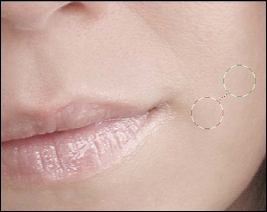
B Camera Raw will create and position a linked source circle in a suitably similar area, and will use pixels from within the source circle to repair the blemish in the target circle.
3. If you need to reposition the target or source circle, drag inside it.C
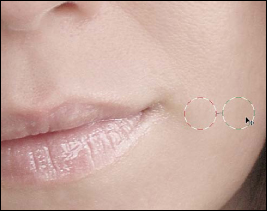
C To control the area from which source pixels are sampled, drag the source circle. Pixels within the target circle will update instantly.
4. From the Type menu, choose Heal to blend source pixels into the texture and luminosity values of the target pixels or Clone to copy the source pixels exactly without healing.
5. You can do any of the following optional steps:
Lower the Opacity value to lessen the retouching effect.
Drag the edge of either circle to resize both circles simultaneously.
Add more circle pairs to correct other blemishes.
6. To hide the circles, press V (Uncheck Overlay) or choose a different tool.
• The spot removal circles will remain available even after you exit Camera Raw. To redisplay them, choose the Spot Removal tool. To remove a selected pair, press Backspace/Delete; to remove all pairs, click Clear All.
Saving and applying Camera Raw settings
After carefully choosing custom settings for a photo in Camera Raw, you’ll be glad to know that you can save those settings as a preset and then apply the preset to other photos that need the same or similar corrections.
To save Camera Raw settings as a preset
Method 1 (Camera Raw Settings menu)
1. With your corrected photo open in Camera Raw, choose Save Settings from the Camera Raw Settings menu. ![]()
2. The Save Settings dialog opens.A Check the categories of settings you want saved in the preset. Or to filter the number of checked boxes, choose a category (tab name) from the Subset menu, then recheck any boxes, if desired.

A In the Save Settings dialog, check which of your custom Camera Raw settings are to be saved in a preset.
3. Click Save. Another Save Settings dialog opens (yes, it’s confusing that the two dialogs have the same name). Enter a name (preferably one that describes the function of the preset), keep the location as the Settings folder, then click Save.
4. The saved settings preset is now available in the Presets tab ![]() for any open photo.
for any open photo.
Method 2 (Presets tab)
1. With your corrected photo open in Camera Raw, click the Presets tab, ![]() then click the New Preset button.
then click the New Preset button. ![]()
2. In the New Preset dialog, enter a name for the preset. Check the settings you want saved in the preset, or choose a category (tab name) from the Subset menu, then recheck any boxes, if desired. Click OK. Your new preset is now available in the tab.
You can apply a user-defined preset (saved collection of settings) to a single photo via Camera Raw (see below), to multiple photos via Bridge (see the following page), or to multiple thumbnails via the synchronize option in Camera Raw (see page 83).
To apply a Camera Raw preset to a photo
Open a photo into Camera Raw, then do either of the following:
Click the Presets tab, ![]() then click a preset name.
then click a preset name.
From the Apply Preset submenu on the Camera Raw Settings menu, choose a preset.
The user-created settings presets that are listed in the Presets tab of the Camera Raw dialog can also be applied to multiple photos via the Develop Settings submenu in Bridge. In fact, you could save presets for specific tabs and settings and assign them to multiple photos in sequence (e.g., a preset for the Basic tab first, then a preset for the Tone Curve tab, and so on). Alternatively, you can copy and paste the settings from one photo into one or more other photos.
To apply Camera Raw settings to multiple photos via Bridge
Method 1 (choose a preset)
1. In Bridge, Ctrl-click/Cmd-click multiple photo thumbnails (or Shift, then Shift-click a consecutive series of photos).
2. To apply settings, from the Edit > Develop Settings submenu, choose a preset.A Choose additional presets, if needed.

A Using the Develop Settings submenu in Bridge, you can apply one or more settings presets to multiple selected thumbnails (or copy and paste the settings from one thumbnail to other thumbnails).
Method 2 (copy settings from a photo)
1. Click the thumbnail for a photo that has the desired settings, then choose Edit > Develop Settings > Copy Camera Raw Settings (Ctrl-Alt-C/Cmd-Option-C).
2. Click another thumbnail (or Ctrl-click/Cmd-click multiple thumbnails), then choose Edit > Develop Settings > Paste Camera Raw Settings (Ctrl-Alt-V/Cmd-Option-V).
3. The Paste Camera Raw Settings dialog opens. Uncheck the settings you don’t want to paste; or choose a tab name from the Subset menu, then remove or add any check marks. Click OK.
• To remove all Camera Raw settings from a selected photo thumbnail in Bridge, choose Edit > Develop Settings > Clear Settings.
• All of the commands that are mentioned on this page are also available via the context menu that opens if you right-click an image thumbnail.
Synchronizing Camera Raw settings
When you open multiple photos into Camera Raw, they are represented by thumbnails in a filmstrip panel on the left side of the dialog. After adjusting one photo, you can click Synchronize to apply those settings to one or more of the other photos. Because it’s unlikely that every single adjustment needed for one photo will be perfectly suited to all the others (even photos from the same shoot), a more practical approach is to adjust subsets of the group. For instance, you could apply a settings preset or some Basic tab adjustments to one photo (say, to correct the white balance and exposure), then apply those settings to most or all of the other photos. Next, you could select incrementally smaller numbers of photos and apply more targeted adjustments.
To synchronize the Camera Raw settings among multiple photos
1. In Bridge, select two or more photo thumbnails, preferably ones that were shot under the same lighting conditions and that require the same kind of correction (to keep things simple, select all raw files or all JPEG files). Double-click one of the selected thumbnails.
2. In the filmstrip panel on the left side of the Camera Raw dialog, click one of the thumbnails.A
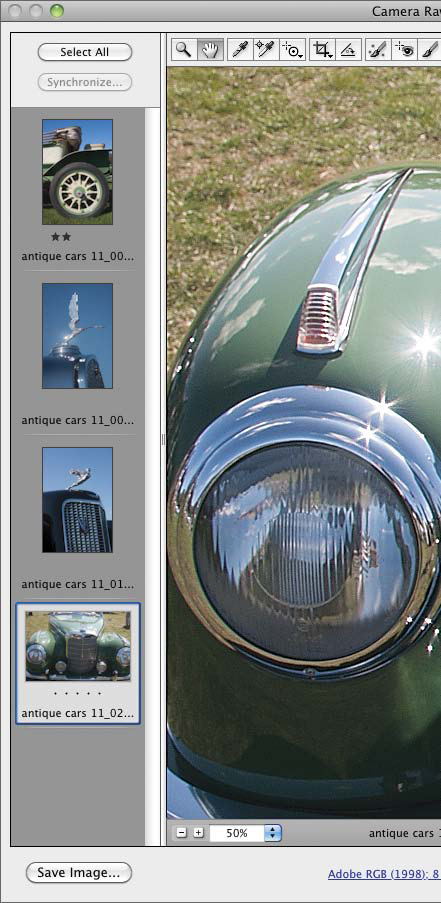
A We opened four photos into Camera Raw. The thumbnails for those images display in the filmstrip panel on the left side of the dialog.
3. Make the needed adjustments to the selected image (including cropping, if you want to crop all the images exactly the same way). You could also apply adjustments by clicking a preset in the Presets tab. ![]()
4. Click Select All at the top of the filmstrip panel or Ctrl-click/Cmd-click the thumbnails to which you want to apply corrections, then click Synchronize. The Synchronize dialog opens (it looks like the Save Settings dialog, which is shown on page 81).
5. Check only the settings to be applied; or choose a category from the Synchronize menu, then remove or add any check marks.
6. To apply the current settings in the categories you checked to all the selected thumbnails, click OK.
• To cycle through the photos in the filmstrip panel, click the left or right arrowhead below the preview (in the lower right). If multiple thumbnails are selected, Camera Raw will cycle among only those photos.
Converting, opening, and saving Camera Raw files
Still with us? At long last, you get to open your Camera Raw file into Photoshop. (Also see the steps for opening a Camera Raw file as a Smart Object on page 249.)
To open a Camera Raw file into Photoshop
1. When you’re done correcting an image in Camera Raw, click Open Image. The current settings will be saved as instructions for converting the photo without altering the original file. (To open multiple images, click Open Images.)
2. Via File > Save in Photoshop, save a copy of the photo in the Photoshop (.psd) format.
• Depending on the setting on the “Save Image Settings In” menu in the Camera Raw Preferences dialog (Ctrl-K/Cmd-K), settings for raw photos (but not JPEGs) are saved either in the internal Camera Raw Database on your system or as hidden Sidecar .xmp files in the same folder as the raw files (not to be confused with the user settings files that are created via the Save Settings command).
• To close the Camera Raw dialog without opening your file, click Done. Your settings will be saved as instructions and will be available if you reopen the file in Camera Raw (via Bridge or Photoshop).
If you need to open a copy of a Camera Raw file without recording settings into the metadata of the raw file or into the actual JPEG file, do as follows.
To open a copy of a Camera Raw file
In the Camera Raw dialog, hold down Alt/Option and click Open Copy (Open Image becomes Open Copy). The file will be converted using the current settings and will open into Photoshop, but the current settings won’t replace any existing instructions in the original raw or JPEG file.
Via the Save Options dialog, you can convert and save a copy of a digital photo in the DNG (Digital Negative), JPEG, TIFF, or Photoshop (PSD) format.
For the DNG format, see the sidebar at right. Camera Raw settings are preserved in DNG files and remain available if you reopen the files in Camera Raw.
When you save a photo in the JPEG, TIFF, or PSD format using the Save Options dialog, your Camera Raw adjustments are applied to it permanently.
Although you can reopen a JPEG or TIFF file into Camera Raw, your custom settings won’t be accessible. (If you need to preserve access to your Camera Raw settings for a JPEG, instead of using this dialog, exit Camera Raw by clicking Done.) PSD files can’t be opened in Camera Raw.
To save a copy of a file in the DNG, JPEG, TIFF, or PSD format
1. In the lower-left corner of the Camera Raw dialog, click Save Image.
2. The Save Options dialog opens. For the Destination, choose Save in Same Location or Save in New Location. For the latter, choose a location in the Select Destination Folder dialog, then click Select.
3. In the File Naming area, enter a file name; if desired, also choose a naming or numbering convention from the adjacent menu.
4. Choose a Format (Digital Negative, JPEG, TIFF, or Photoshop), then choose format-related options. For instance, if you cropped the photo in Camera Raw and chose the Photoshop format, check whether you want to Preserve Cropped Pixels.
5. Click Save.






